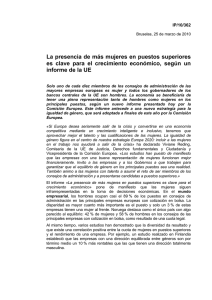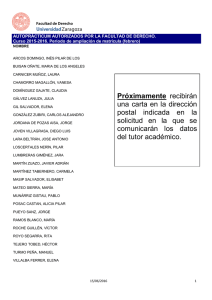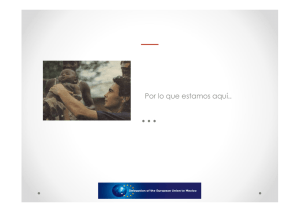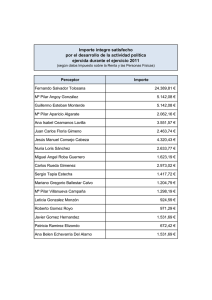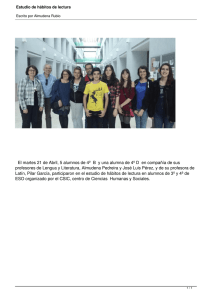Pilar López Sancho
Anuncio
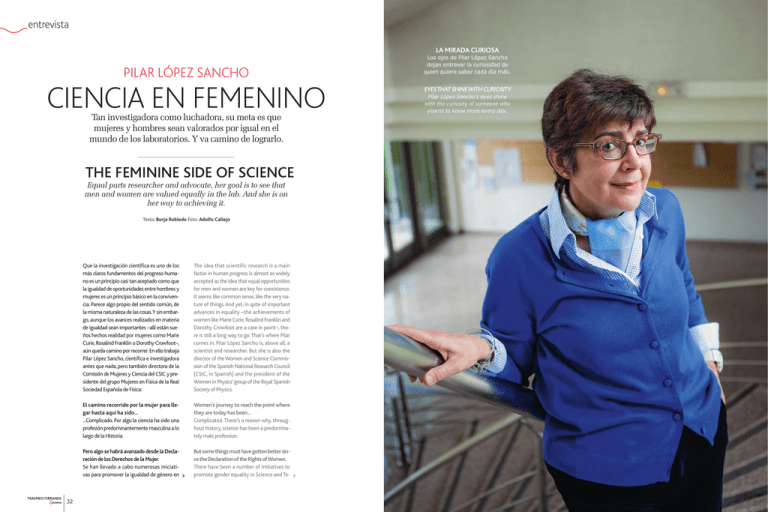
entrevista entrevista la mirada curiosa Pilar lópez sancho CIENCIA EN FEMENINO Tan investigadora como luchadora, su meta es que mujeres y hombres sean valorados por igual en el mundo de los laboratorios. Y va camino de lograrlo. Los ojos de Pilar López Sancho dejan entrever la curiosidad de quien quiere saber cada día más. Eyes that shine with curiosity Pilar López Sancho’s eyes shine with the curiosity of someone who yearns to know more every day. THE FEMININE SIDE OF SCIENCE Equal parts researcher and advocate, her goal is to see that men and women are valued equally in the lab. And she is on her way to achieving it. Texto: Borja Robledo Foto: Adolfo Callejo 32 Que la investigación científica es uno de los más claros fundamentos del progreso humano es un principio casi tan aceptado como que la igualdad de oportunidades entre hombres y mujeres es un principio básico en la convivencia. Parece algo propio del sentido común, de la misma naturaleza de las cosas. Y sin embargo, aunque los avances realizados en materia de igualdad sean importantes –allí están sueños hechos realidad por mujeres como Marie Curie, Rosalind Franklin o Dorothy Crowfoot–, aún queda camino por recorrer. En ello trabaja Pilar López Sancho, científica e investigadora antes que nada, pero también directora de la Comisión de Mujeres y Ciencia del CSIC y presidente del grupo Mujeres en Física de la Real Sociedad Española de Física: The idea that scientific research is a main factor in human progress is almost as widely accepted as the idea that equal opportunities for men and women are key for coexistence. It seems like common sense, like the very nature of things. And yet, in spite of important advances in equality –the achievements of women like Marie Curie, Rosalind Franklin and Dorothy Crowfoot are a case in point–, there is still a long way to go. That’s where Pilar comes in. Pilar López Sancho is, above all, a scientist and researcher. But she is also the director of the Women and Science Commission of the Spanish National Research Council (CSIC, in Spanish) and the president of the Women in Physics’ group of the Royal Spanish Society of Physics. El camino recorrido por la mujer para llegar hasta aquí ha sido... ...Complicado. Por algo la ciencia ha sido una profesión predominantemente masculina a lo largo de la Historia. Women’s journey to reach the point where they are today has been... Complicated. There’s a reason why, throughout history, science has been a predominately male profession. Pero algo se habrá avanzado desde la Declaración de los Derechos de la Mujer. Se han llevado a cabo numerosas iniciativas para promover la igualdad de género en But some things must have gotten better since the Declaration of the Rights of Women. There have been a number of initiatives to promote gender equality in Science and Te- 33 entrevista entrevista “El acceso y la igualdad en los puestos de trabajo deben primar tanto como el principio de la meritocracia” BIO-PIC PILAR LÓPEZ SANCHO El CSIC, en Madrid, es donde Pilar López Sancho ejerce su trabajo; y también su centro de actividades a favor de las mujeres científicas. The CSIC, in Madrid, is where Pilar López Sancho does her work; it is also her home base for activities aimed at helping women scientists. Ciencia y Tecnología, como la Association for Women in Science en Estados Unidos y en Europa, la formación del Grupo Helsinki para examinar la situación de las mujeres en ciencia en 30 países, o el plan de acción de la red ETAN (European Technology Assessment Network) para promover la igualdad de género. ¿Y la Comisión de Mujeres y Ciencia del CSIC que usted preside desde 2008? Viene respondiendo a las demandas de la sociedad española desde su creación en 2002. Estudiamos las causas que dificultan el ingreso y la carrera de las mujeres dentro de la ciencia, proponiendo acciones destinadas a conseguir la paridad. Creemos firmemente en la investigación, la divulgación y el progreso, pero sin gestos jamás habrá hechos. ¿Se refiere a gestos políticos? Sí. Las iniciativas legislativas como la Orden de 2005 sobre el equilibrio de ambos sexos en todas las comisiones del Poder Ejecutivo o la Ley de Violencia de Género han reali- 34 chnology, including the establishment of the Association for Women in Science in the United States and Europe, the foundation of the Helsinki Group, which examines the situation of women in science in 30 countries, and the development of an action plan to promote gender equality by the European Technology Assessment Network (ETAN). What about the CSIC’s Women and Science Commission that you have presided over since 2008? It has been addressing issues in Spanish society since its creation in 2002. We study the reasons why women have a hard time breaking into the field and the difficulties women in science face throughout their careers in order to propose measures to achieve greater equality. We are firm believers in research, information sharing and progress, but without gestures, we’ll never have facts. Do you mean political gestures? Yes. Legislative initiatives, like the 2005 Or der that called for gender equality in all of the Investigación: Ha desarrollado numerosos proyectos financiados por la Comisión Europea, entre ellos estudios sobre grafeno y nanotubos de carbono. Research: Pilar has carried out several research projects financed by the European Commission, including studies on graphene and carbon nanotubes. Docencia: Profesora de Investigación del CSIC. Ha realizado estancias en el Imperial College of London, el Centro de Investigación Interdisciplinar en Superconductividad (Cambridge) y el Instituto de Física Teórica (California). Teaching Experience: Pilar is a Research Professor at the CSIC. She has also been a visiting scholar at the Imperial College of London, the Interdisciplinary Research Centre in Superconductivity at Cambridge, and the Institute for Theoretical Physics in California. Divulgación: Autora de más de 80 publicaciones científicas y libros didácticos. Coautora de El segundo escalón. La dimensión de género en la física. Publications: Pilar is the author of more than 80 scientific papers and educational books. She is also coauthor of “El segun¬do escalón. La dimensión de género en la física”. Compromiso: Preside la Comisión de Mujeres y Ciencia del CSIC. Dirigió la Asociación de Mujeres Investigadoras y Tecnólogas (AMIT). Integra el colectivo Mujeres en Física. Community Engagement: Pilar presides over the CSIC’s Women and Science Commission. She also directed the Association of Women Researchers and Technologists (AMIT) and is a member of the Women in Physics group. zado importantes avances para la equidad. Pero se debe primar tanto la accesibilidad e igualdad en puestos de trabajo como el principio fundamental de la meritocracia. Introducir estos conceptos en la sociedad es más complejo de lo que pensamos. Queda camino por andar y mucho por hacer… ¿El ámbito de la conciliación familiar es un buen sitio para trabajar estos temas? La educación en la responsabilidad compartida es importante, pues la etapa fértil de la mujer científica coincide con la post-doctoral. Por otro lado, la avenencia es complicada cuando el reparto de tareas domésticas recae fundamentalmente en la mujer. Por fortuna, esto empieza a cambiar. ¿Cuáles son los últimos datos en materia de igualdad? Vale más una mirada hacia atrás que hacia delante. En el pasado, ser Jefa de Estado, lo que en ocasiones determina nuestros juicios y valoraciones, era algo impensable. Según el Instituto Europeo de Igualdad, el índice está en un 54% de media. Hemos avanzado considerablemente, pero debemos luchar por alcanzar la igualdad total. commissions of the Executive Branch and the Law on Gender-Based Violence, have secured important advances in gender equality. But we should also give priority to job accessibility and equality as basic principles of a meritocracy. Introducing these concepts into society is more complicated than we think.We still have a long way to go and a lot to do… Is the work-life balance debate a good place to address these issues? Education in shared responsibility is important, especially since, for women scientists, peak child-bearing years often coincide with their post-doctoral studies. This situation is further complicated by a division of household labour that leaves women with most of the work. Fortunately, this is starting to change. What’s the latest data on gender equality? Looking back can tell us more than looking forward. In the past, being a Head of State −a post that sometimes determines our values and opinions− was basically unthinkable. According to the European Institute for Gender Equality, the average rate is now at 54%. We have made great strides, but we should continue fighting to achieve full equality. Personal científico por escalas Ranking of Scientific Porcentaje Doctora en Física e investigadora del Instituto de Ciencia de Materiales. Doctor of Physics and Researcher at the Instituto de Ciencia de Materiales. 90 80 70 60 50 40 30 20 10 0 PI IC CT Profesores de investigación/ Research professors Investigadores científicos/ Scientific researchers Científicos tutulares/ Tenured scientists Hombres Mujeres Total 575 565 847 175 296 589 75023,33% 86334,38% 143041,02% 1987 1060 304734,79% 35 entrevista “La ciencia conlleva grandes sacrificios, pero resulta muy gratificante. Para mí, es la verdadera filosofía” El compromiso de género ocupa buena parte del tiempo de Pilar López Sancho. Pero antes que nada está la ciencia, la actividad que ha elegido y ejerce con pasión: “Conlleva grandes sacrificios, pero es una profesión más que gratificante, la verdadera filosofía”. ¿Cómo fue su ruta en el área del saber? Estudié en un colegio de monjas hasta que en cuarto pasé a cursar ciencias en el Instituto Beatriz Galindo. En un principio dudé entre Matemáticas o Físicas. Pero fue descubrir las leyes del Universo y me dediqué en cuerpo y alma a la Física. glosario básico Basic glossary No es fácil entender los temas que investiga Pilar López Sancho. He aquí una breve explicación de cada uno. Propiedades del grafeno: La aplicación del material más fino y resistente del mundo. Nanotubos de carbono: Estudio de estas estructuras conductoras de la electricidad, utilizables en células solares, ordenadores portátiles y teléfonos móviles. Física de superficies: Análisis de los fenómenos que ocurren en superficies sólidas, líquidas y gaseosas, como el comportamiento atómico en el Universo. Quimisorción: Determinación de los componentes sólidos responsables de las reacciones químicas. Teoría de sistemas de baja dimensionalidad: Propiedades ópticas, eléctricas y magnéticas de los semiconductores. Sistemas de electrones: Investigación sobre la cadena de transporte de electrones. Superconductores de alta temperatura: Síntesis de materiales complejos que se aplican en grandes campos magnéticos y cables de transmisión de energía. 36 It’s not easy to understand Pilar López Sancho’s research topics. Here is a brief explanation of each one. Graphene properties: The application of the world’s thinnest and most resistant material. Carbon nanotubes: The study of these electricity conducting structures, which can be used in solar cells, portable computers and mobile phones. Surface physics: The analysis of phenomena that occur on solid, liquid and gas surfaces, such as the behaviour of atoms in the universe. Chemisorption: The analysis of the solid components responsible for chemical reactions. Theory of low dimensional systems: The optical, electrical and magnetic properties of semiconductors. Electron systems: Research on the electron transport chain. High temperature super-conductors: A synthesis of complex materials that are used in large magnetic fields and power cables. Pilar López Sancho sostiene que la discriminación de la mujer en el ámbito científico es tan sutil que solo con el tiempo es posible detectarla. Pilar López Sancho believes that discrimination against women in science is so subtle it can only be detected with time. Y de allí, directa al estudio de técnicas experimentales o la interacción de gases con superficies de metales... Y quimisorción, sistemas de baja dimensionalidad, propiedades electrónicas de superficies, heteroestructuras, sistemas de electrones... No extraña que el CSIC le echase el ojo... Entré en el Consejo Superior de Investigaciones Científicas cuando salieron las becas de formación de personal investigador. Así realicé mi tesis; fueron mis inicios en la organización. Para terminar hablemos del grafeno, el material más fino del mundo. Ha sido un descubrimiento importantísimo. Hace tiempo que trabajo en sus propiedades electrónicas y en los nanotubos de carbono. ¿Es cierto que podría transformar el mundo multimedia y los objetos más cotidianos? Al ser un material tan elástico y resistente, los electrones tienen gran movilidad. La idea de fabricar tablets cuyo soporte sean láminas plegables no sería posible sin el grafeno. Pero además, su aplicación en medicina es más que prometedora. Pilar López Sancho’s commitment to the fight for gender equality takes a great deal of her time. But science, her chosen career, which she practices with a passion, comes first: “It demands huge sacrifices, but it is a more than gratifying profession. It is the real philosophy.” What was your path to knowledge like? I studied in a parochial school until fourth grade. Then I started studying science at the Instituto Beatriz Galindo. At first, I couldn’t decide between Math and Physics. But once I discovered the Laws of the Universe, I jumped into Physics body and soul. And from there, straight to studying experimental techniques and interactions between gases and metal surfaces... And chemisorption, low dimensional systems, surface electron properties, heterostructures and electron systems... It’s not surprising that the CSIC took an interest in you... I got my start with the Spanish National Research Council when they came out with training grants for researchers. That’s how I did my thesis; that’s how I started working for the organisation. To wrap up, let’s talk about graphene, the world’s thinnest material. It’s been a very important discovery. I’ve been working on its electronic properties and on carbon nanotubes for some time. Is it true that it could transform the world of multimedia and everyday objects? Being such an elastic and resistant material, electrons are highly mobile. The idea of making flexible tablets would not be possible without graphene. But its applications in medicine are also more than promising. 37
